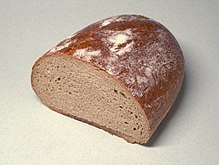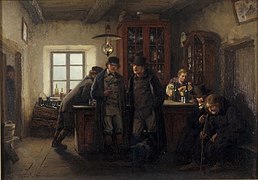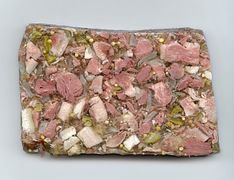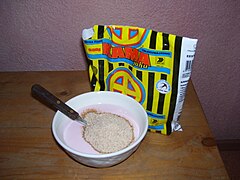Estonian cuisine
| Part of a series on the |
| Culture of Estonia |
|---|
 |
| People |
| Languages |
| Cuisine |
| Festivals |
| Religion |
| Sport |
Traditional Estonian cuisine has substantially been based on meat and potatoes, and on fish in coastal and lakeside areas, however now bears influences from many other cuisines, including a variety of international foods and dishes, with a number of contributions from the traditions of nearby countries. German, Scandinavian, Russian, Finnish and other influences have played their part. The most typical foods in Estonia have been rye bread, pork, potatoes and dairy products.[1] Estonian eating habits have historically been closely linked to the seasons. In terms of staples, Estonia belongs firmly to the beer, vodka, rye bread and pork "belt" of Europe.
Cold table

The first course in traditional Estonian cuisine is based on cold dishes—a selection of pickles, meats and sausages served with potato salad (kartulisalat) or rosolje, an Estonian signature dish almost identical to Swedish sillsallad, based on beetroot, potatoes and herring.[2] Small pirog pastries called pirukad (pirukas in the singular) filled with meat, fish, cabbage, carrots, and other fillings or mixtures are also popular, and are often served with puljong (bouillon broth). Herring is common among other fish as a part of the Estonian cold table. Smoked or marinated eel, crayfish dishes, and imported crabs and shrimp are considered delicacies. One of Estonia's national dishes is räim (Baltic dwarf herring), along with sprats. Flounder, perch and pike-perch are also popular.[citation needed]
In the 20th century, a special sandwich called kiluvõileib has become popular. This sandwich consists of a traditional rye bread open sandwich with thin layer of butter and a layer of vürtsikilu (pickled Baltic sprats) as topping. Boiled egg slices and culinary herbs are optional extra toppings.[citation needed]
Soups
Soups traditionally formed a main meal option and nowadays are more often eaten as first course. Soups are typically made of meat or chicken stock mixed with a variety of vegetables, eggs, pork or fish. Soups are also blended with sour cream, milk, butter and yogurt. Pea soup is also quite popular.[2]
Main course


Black bread leib (or rukkileib, i.e "rye bread") accompanies almost every savory food in Estonia. Estonians continue to value their varieties of black rye-based bread.[citation needed]
Desserts
Typical Estonian desserts include mannavaht (a cream made of semolina and juice or fruit), kohupiimakreem (creamy curd), kohuke (curd snack), kompott (compote) and kama. A unique form of Estonian dessert is leivasupp ("bread soup"), which is a type of sweet soup that is made of black bread and apples, normally served with sour cream or whipped cream, often seasoned with cinnamon and sugar.[citation needed] Rhubarb pies are also a favorite.
Another popular dessert is kringel (kringle), a sweet yeast bread often flavored with cardamom. Pancakes (pannkook, plural pannkoogid) are also traditional, common and popular. They are fried and often have sweet fillings and can be savoury as well. Vastlakukkel, a cardamom-spiced bread roll with whipped cream is a traditional Estonian sweet roll, especially popular during the festivities of vastlapäev.[3]
Drinks
Nowadays, locally brewed beer is the number one choice to accompany food; different juices or simply water being the main non-alcoholic choice. Wine is the second most widely drunk alcoholic beverage, however its consumption in liters is overshadowed by the beer consumption that is roughly 5 times more than the consumption of wine or consumption of all the spirits.[4] There are also Estonian fruit wines made of apples or different berries. Estonia is also known for locally produced viin (vodka) and other distilled spirits. Mead (mõdu), the alcoholic drink that was most popular in ancient times, has almost completely disappeared.
Some other drinks whose popularity peaked in the 20th century, however are still consumed by some Estonians, include kali (similar to kvass) and birch sap (kasemahl) beverages.
Besides milk (piim) other widely consumed dairy products include keefir and also hapupiim ("sour milk") and pett, which are variations on the theme of buttermilk.
Seasons
Summer and spring
Traditionally in summer and spring, Estonians like to eat everything fresh—berries, herbs, vegetables and everything else that comes straight from the garden. Hunting and fishing were common in history. Nowadays, they have remained as popular pastimes. It is popular to barbecue in the summer.[citation needed]
Winter and Christmas
During the winter months, jam, preserves and pickles are brought to the table. In the not so distant past, the gathering and conserving of fruits, edible mushrooms and vegetables for winter was more common, nowadays it is less so as almost everything can be bought from stores. However, preparing food for winter is still popular in the countryside and continues to retain its charm for many, as opposed to the commercialization of eating habits.[citation needed]
Oven-grilled pork, blood sausage (verivorst), roast goose (jõuluhani), jellied pork (sült), sauerkraut (hapukapsas) with oven-roasted potatoes, and mulled wine (hõõgvein, or glögi) have been part of the traditional Estonian menu that nowadays are mostly Christmas specialties. Also, typical Christmas treats have been apples, mandarin oranges, gingerbread, pickled pumpkin (kõrvitsasalat), and lingonberry jam.[citation needed]
Gallery
-
Estonian farmers in an inn, drinking viin (vodka), painting by Oskar Hoffmann, 1899.
-
Bread retailed from street counters in Tallinn (photo from The Encyclopedia of Food by Artemas Ward, 1923)
-
Rye bread (leib) is also eaten as a pub snack.
-
Small over-cooked verivorst blood sausages
-
Traditional sausages at display in an Estonian street market, 2013.
-
World's largest kiluvõileib fish sandwich was created in 2014 in Tallinn.[5]
-
Sült (pieces of meat in jellied pork brawn).
-
Mulgipuder, a traditional dish of southern Estonia made with potatoes, groats, and meat.
-
Hernetatrapuder, a pea and buckwheat porridge.
-
Kama, a cereal and legume flour is traditionally eaten mixed with just milk or buttermilk, now also used for making desserts.
Notes and references
- ^ Eesti Toit infoserver v2.0.3.0 Archived December 17, 2007, at the Wayback Machine
- ^ a b Estonia By Michael Spilling
- ^ Rosa, Natalia (27 February 2020). "A first timer's guide to wholesome and delicious Estonian Food". Trafalgar.com. Retrieved 13 May 2023.
- ^ "Alcohol market, consumption and harms in Estonia Yearbook 2022".
- ^ "Raekoja platsil valmib maailma pikim kiluvõileib". Tallinn. Postimees (in Estonian). 14 May 2014. Archived from the original on 13 October 2016. Retrieved 13 October 2016.
External links
- Articles containing Estonian-language text
- Webarchive template wayback links
- CS1 Estonian-language sources (et)
- Articles with short description
- Short description is different from Wikidata
- Articles with excerpts
- Articles containing Swedish-language text
- All articles with unsourced statements
- Articles with unsourced statements from December 2022
- Commons category link is on Wikidata
- Articles with J9U identifiers
- Articles with LCCN identifiers
- Articles with LNB identifiers
- Estonian cuisine





![World's largest kiluvõileib fish sandwich was created in 2014 in Tallinn.[5]](http://upload.wikimedia.org/wikipedia/commons/thumb/4/4d/Kiluv%C3%B5ileib.IMG_4378.JPG/132px-Kiluv%C3%B5ileib.IMG_4378.JPG)



